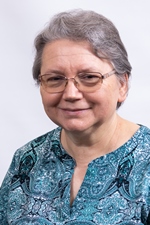Mathematics and Statistics

Associate Professor, Math & Stats Centre Coordinator (on leave)
Mathematics and Statistics
Abbotsford campus, G161
Phone: 604-504-7441 ext. 4313
email Anna WebsiteI work in and coordinate the operation of the Math & Stats Centre as well as teach mathematics courses for the Upgrading and University Preparation Department.
I was born in Warsaw, Poland. My love for mathematics dictated my choice of secondary school, which specialized in mathematics and physics, and later my studies at Wroclaw and Warsaw Universities. During my graduate studies, I was specifically interested in topology, algebraic topology, and analysis. After obtaining Master’s Degree in Theoretical Mathematics in Poland, I emigrated with my family to Canada, where I worked my way to becoming a mathematics instructor at UFV. This involved working on my English skills, completing the PDP program at SFU to obtain the BC Teaching Certification, volunteering at various schools and colleges, tutoring in a variety of settings, and working as a sessional instructor for many years. My family life awarded me with a wonderful daughter, who exceeded my skills in many areas, especially in the education of mathematics. Presently, I work at UFV as an associate professor for UUP and as the Math & Stats Centre coordinator for the Math & Stats Department.
Master in Theoretical Mathematics (Warsaw, Poland)
Professional Development Program (SFU)
Professional Teaching Certificate (BC)
Studying and teaching mathematics has always been a big part of my life. I see mathematics not as a collection of concepts, formulas, and calculation skills, but rather, as a logical and analytical way of thinking that can be helpful in everyday life. This guides my approach to teaching mathematics.
Mathematics is usually quite difficult for students, and I know that it can easily become frustrating to learn. Therefore, I like to focus on encouraging my students to pose relevant questions and to search for various ways of solving a problem before giving up. I believe in keeping my students in a zone of proximal development, where they are given tasks that slightly exceed their present abilities so that they will always feel challenged without being overwhelmed. This is a difficult balance to achieve, especially in courses with a lot of content.
Over the years, I gradually shifted my teaching approaches from teacher-centered to more student-centered. Currently, I focus on creating a space for students to actively participate in exploring concepts and solving problems. In my classes, students frequently work in small groups on vertical whiteboards. This allows for opportunities for discussion, knowledge exchange, and application of concepts. Short lessons about concepts emerge as needed during class time; however, the detailed lectures are available online. There are many benefits to this approach. Students learn how to communicate mathematically, sometimes get creative and challenge themselves, and overall become more confident, persistent, and inquisitive learners.
In summary, my primary objective in teaching mathematics is to thoroughly prepare students for subsequent courses, as well as to promote analytical thinking, inquiry, independent and collaborative learning. Some of the recent technological developments have helped me greatly in achieving these goals.
- flipped and thinking classroom strategies;
- developing online resources.
Intermediate Algebra and Trigonometry for Math 085 – online text